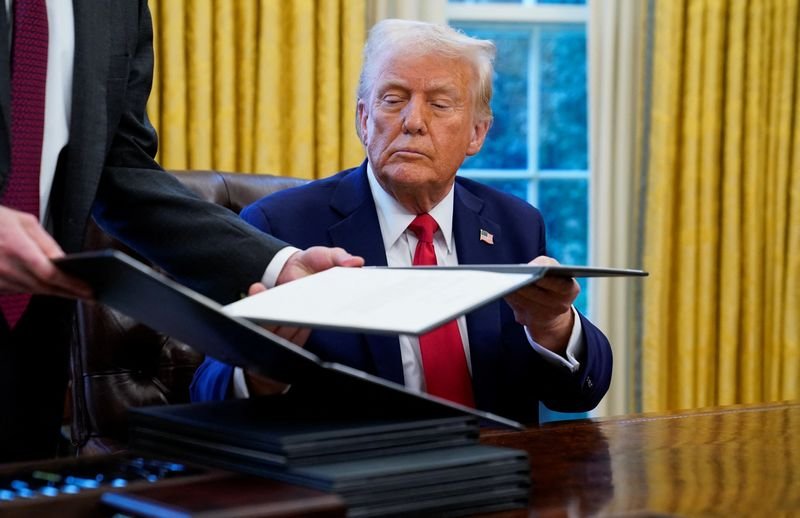President Donald Trump in his inaugural speech credited President William McKinley for making the United States “very rich” through tariffs.President Donald Trump in his inaugural speech credited President William McKinley for making the United States “very rich” through tariffs.
President Donald Trump has long been a fan of tariffs, and in his first month back in the White House he wasted no time imposing new — and relatively high — tariffs on imported goods from Canada, Mexico and China.
While Trump has suspended the tariffs on Canada and Mexico for at least one month while those countries negotiate with the United States on trade and border security, new 10% tariffs on Chinese imports began this week.
And given Trump’s history, it is likely that he will wield the threat of tariffs again during his next four years in office.
CNBC spoke with trade expert David Gantz to get answers to the questions many Americans might have about tariffs after seeing a flurry of headlines about Trump’s favorite trade negotiation tool in the past week.
Gantz is the Will Clayton Fellow in Trade and International Economics at Rice University’s Baker Institute for Public Policy, and previously served as the U.S. judge on the Administrative Tribunal of the Organization of American States, as well as a consultant for the World Bank.
What is a tariff?
“It’s essentially a tax on imported goods,” Gantz said. “The tax is determined by … the value of the goods declared by the exporters.”
“For some commodities, it’s a price per ton, but on essentially all consumer goods it’s the value of the product,” Gantz said.
“Typically the value is what an independent buyer would pay to an independent seller.”
Goods subject to tariffs can be commodities or other raw materials, such as steel; component products, such as automobile transmissions; and finished products, such as a Mercedes-Benz sedan.
Tariffs are usually a percentage of the value of the imported good. For a tariff of 2.5%, the duty paid would be $2.50 for every $100 value of goods.
Who pays the tariff?
“Under the law, the importer is responsible for paying the tariff,” Gantz said.
A U.S. automobile company, for example, would pay the tariff on a transmission imported from Korea that the company will use to assemble an SUV.
“But” — and it’s a big but — “the importer under normal circumstances would transfer it up the line to the wholesaler, to the distributor, and ultimately to the consumer,” Gantz noted.
In other words, while an importer will initially pay the tariff, another company and eventually the end user, or consumer, will foot most or some of its cost.
Gantz used the example of crude oil drilled in Alberta, Canada, and shipped via pipeline to the United States, where it ends up being refined into gasoline or diesel fuel.
Under Trump’s now-suspended tariffs, energy products imported from Canada would be subject to a 10% levy. If Alberta crude is selling for $60 a barrel, the additional tariff will be $6 per barrel imported.
Because profit margins on gasoline “are very, very small,” Gantz said, “the full cost of the $6 is going to be passed on” to the consumer at the pump of BP stations and elsewhere.
“BP is not going to absorb any part of the additional $6 or whatever it is,” he said.
In addition to gasoline, consumers are most likely to see price hikes that fully reflect the tariff rate on perishable food items such as fruits and vegetables, where profit margins likewise are low, Gantz said.
But for importers with higher profit margins, “if you have a relatively high mark-up, such as branded footwear, you may be able to absorb much of the additional cost” from tariffs without passing it all on to the consumer, he said.
Who collects tariffs?
“Tariffs are collected by Customs and Border Protection, a division of the Department of Homeland Security,” Gantz said.
But “it’s paid directly into an account that directly goes into the Treasury,” he said.
The Treasury Department, which previously had oversight over CPB, is responsible for collecting revenue for the U.S. government.
How much does the U.S. government get from tariffs?
Not much — despite previously being very much.
In fiscal year 2024, the U.S. collected just $77 billion in tariffs, which amounts to about 1.5% of all federal revenue, according to the Congressional Research Service.
“Over the past 70 years, tariffs have never accounted for much more than 2% of total federal revenue,” CRS says.
Why are tariffs used?
When the United States became a country in the late 18th century, tariffs “were the principal source of government revenue, because we did not have an income tax until 1913,” Gantz said.
“For well over 100 years they were the major source of U.S. government revenues,” he said.
Tariffs are “also very easy to collect,” Gantz said. “Import tax is collected at the border, and if you don’t pay the tax you don’t get your good.”
“They were also used over those years to protect new industries … particularly in New England.”
High tariffs meant that products imported into the U.S. had a competitive disadvantage to products sourced in the U.S.
Protectionist tariffs remain in the U.S., such as in the steel industry, where imported steel is subjected to levies.
Why are they less common today?
Tariffs became a less important source of federal revenue in the U.S. after a federal income tax was re-established in 1913, and tariff rates were sharply lowered.
In 1930, Congress passed the Smoot-Hawley Tariff Act, which raised levies on a broad range of imports in an effort to protect U.S. businesses during the onset of the Great Depression. The act led to retaliatory tariffs by other countries and is widely seen as exacerbating the economic misery of the Depression.
“If we raise our tariffs, other countries raise their tariffs,” Gantz said.
He noted that after Trump said that he would impose a 25% tariff on imports from Canada, that country “came up with a very detailed list of about $150 billion of U.S. imports that they were going to increase import taxes on,” with a focus on good from states whose legislators supported the U.S. tariffs.
China on Tuesday said it will impose additional tariffs of 15% on coal and liquefied natural gas imported from the United States, and extra 10% duties on U.S. crude oil, agricultural machinery, and some cars.
But Gantz said that having tariffs relatively lower than they were during the 19th century can benefit U.S. consumers, who are also voters.
“If we have low tariffs on goods from China, that probably saves families $2,000 or $3,000 per year on everything from television sets to Barbie dolls,” Gantz said.
“And that $2,000 or $3,000 has been very important to low-income workers because they don’t have much money,” he said.
What about Trump?
In his recent inaugural address, Trump lauded former President William McKinley, who served in the White House from 1897 until he was assassinated in 1901. As a member of the House of Representatives, McKinley championed the McKinley Tariff of 1890, which sharply raised import levies.
“President McKinley made our country very rich through tariffs and through talent,” Trump said in his speech.
Gantz said that imposing tariffs for the reason that Trump recently cited — stemming the flow of migrants and the deadly opioid fentanyl from Mexico, Canada and China — was not a common rationale for tariffs.
“But they weren’t the only reason,” Gantz said.
“Trump for years has been unhappy with the trade deficit we’ve run with Canada and Mexico,” he said. “And he has also talked about how to get companies in Canada and Mexico to move to the United States.”
Trump also sees tariffs as a source of revenue that “will make it easier to decrease taxes, primarily on wealthy people,” Gantz said. “That’s the theory.”
“He loves them. He thinks they’re the solution to everything.”
Discover more from World Byte News
Subscribe to get the latest posts sent to your email.




